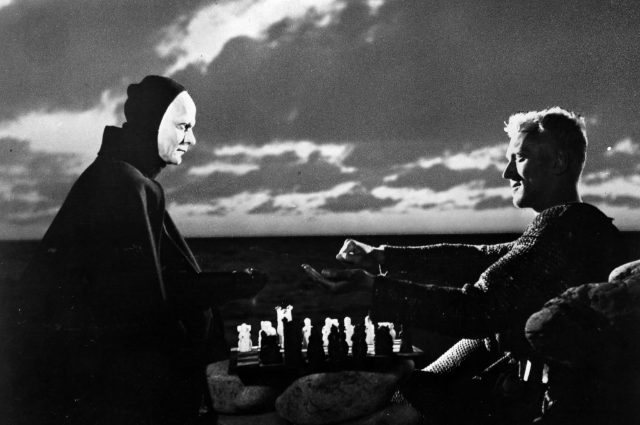Ingmar Bergman's 1957 worldview, "The Seventh Seal" (Swedish title: "Det sjunde inseglet"), stands as a monumental and contemplative work of cinema that weaves existentialism, faith, and death into a tapestry of profound symbolism and thought-provoking narratives. Bergman, a luminary in the realm of world cinema, employs a variety of cinematic devices and motifs to explore his intricate vision of the human condition. The film's themes and their cinematic representation echo across the landscape of international cinema, marking Bergman as a storyteller of global resonance.
"The Seventh Seal" opens with a shot of a desolate beach, where the medieval knight Antonius Block (Max von Sydow) and his squire Jöns (Gunnar Björnstrand) have returned from the Crusades. This stark, almost apocalyptic imagery, reminiscent of German Expressionism, immediately establishes the film's bleak tone. Block's quest for meaning and his encounter with Death (Bengt Ekerot), a central allegorical figure, resonate with viewers across cultures and time.
In discussing, Bergman's perspective in this film, one cannot help but draw parallels to the works of French existentialist philosophers such as Jean-Paul Sartre and Albert Camus. Block's existential crisis and his ceaseless questioning of the existence of God mirror the philosophical inquiries of Sartre's "Being and Nothingness." Sartre's assertion that "Man is condemned to be free" aligns with Block's predicament, trapped between the forces of life and death, yearning for a divine truth in a seemingly indifferent world.
Moreover, Bergman's use of chiaroscuro lighting and evocative symbolism in "The Seventh Seal" has been likened to the expressionist aesthetics of German cinema, notably the works of F.W. Murnau and Fritz Lang. The stark black-and-white imagery and haunting compositions evoke a sense of impending doom, reminiscent of Murnau's "Nosferatu" and Lang's "Metropolis." These visual elements contribute to the film's transcendent and universally relatable atmosphere.
Bergman's exploration of faith and doubt is not confined to a single language or culture. His multilingual storytelling approach,(which is my favorite, I'm also adding a famous bengali line,"নানা ভাষা নানা মত নানা পরিধান, বিবিধের মাঝে দেখ মিলন মহান')which included a mix of Swedish and Latin dialogue, serves as a testament to the universality of these profound inquiries. The use of Latin, a language of the Church, adds a layer of theological significance, highlighting the omnipresent theme of religious questioning that is found in various cultural and linguistic contexts.
In the next part of this essay, I will delve further into Bergman's character development, the iconic chess game with Death, and the film's allegorical richness, drawing parallels with cinematic works from around the world. "The Seventh Seal" is a cinematic masterpiece that transcends linguistic and cultural boundaries, inviting audiences to ponder the complexities of human existence and spirituality.
One of the most iconic and allegorical scenes in "The Seventh Seal" is the chess game between the knight Antonius Block and Death. This metaphorical battle for life and meaning has reverberated through the annals of cinematic history, drawing comparisons to similar philosophical conflicts in other films.
In Akira Kurosawa's "Ikiru," we witness a dying bureaucrat's quest for meaning in the face of death. The parallels with Block's journey are unmistakable. Both characters grapple with existential questions, attempting to make sense of their lives before the inevitable end. Kurosawa, like Bergman, masterfully navigates the themes of mortality and the search for purpose, employing visual and narrative techniques to invite contemplation.
Furthermore, the chess match is reminiscent of the absurdity and futility explored in the works of Samuel Beckett, particularly in his play "Endgame." In both "The Seventh Seal" and "Endgame," characters engage in intellectual duels while surrounded by a world that appears to be devoid of meaning. Beckett's quote, "You must go on. I can't go on. I'll go on," echoes the relentless quest for meaning embodied by Block, who faces Death with a determination to find answers, even in the face of uncertainty.
Bergman's depiction of Death as an enigmatic and, at times, even sympathetic figure, recalls the portrayal of the Reaper in Terry Gilliam's "The Fisher King." Gilliam's film also uses a supernatural character (element) to provoke introspection and provide insight into the human psyche. In both cases, Death is not merely a malevolent force but a catalyst for deeper self-examination and spiritual exploration.
As I examine Bergman's global impact, it's worth noting that "The Seventh Seal" has influenced contemporary filmmakers such as Lars von Trier, who explores themes of faith and despair in films like "Breaking the Waves." Von Trier's work, like Bergman's, challenges conventional storytelling and embraces an unflinching examination of the human condition.
"The Seventh Seal" transcends linguistic and cultural boundaries to become a universal, social touchstone for philosophical reflection and artistic innovation. Bergman's cinematic language, inspired by international influences, resonates across time and space, inviting audiences from diverse backgrounds to ponder the complexities of existence and the enduring quest for meaning. The film's ability to evoke existential inquiries in viewers worldwide cements it as a timeless masterpiece of global cinema.

